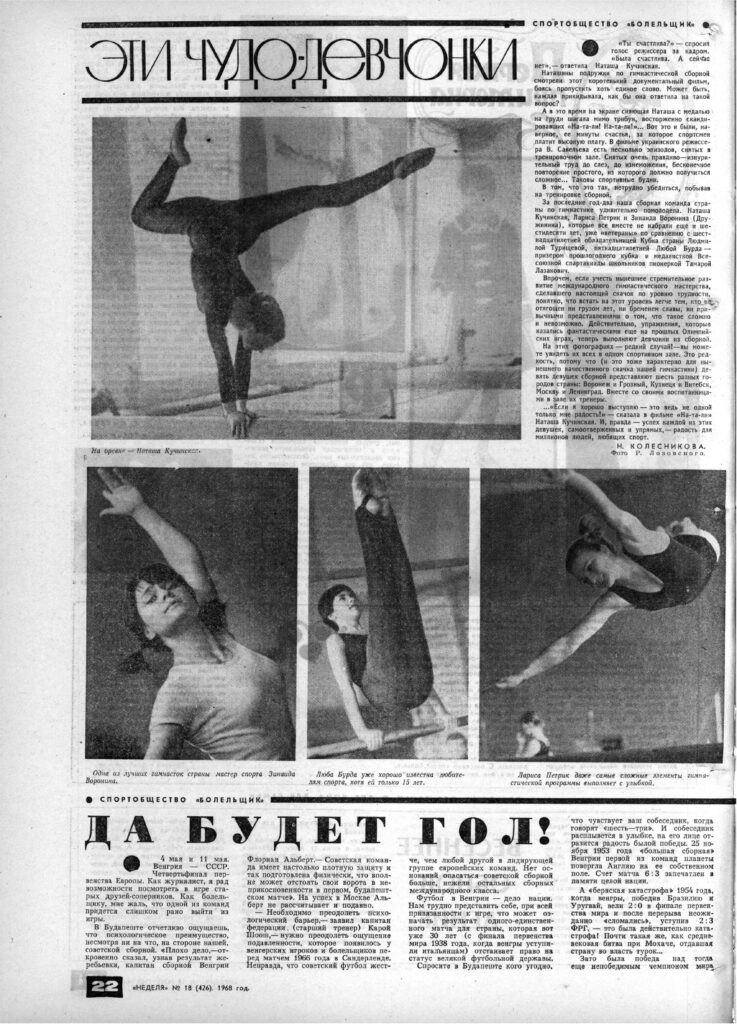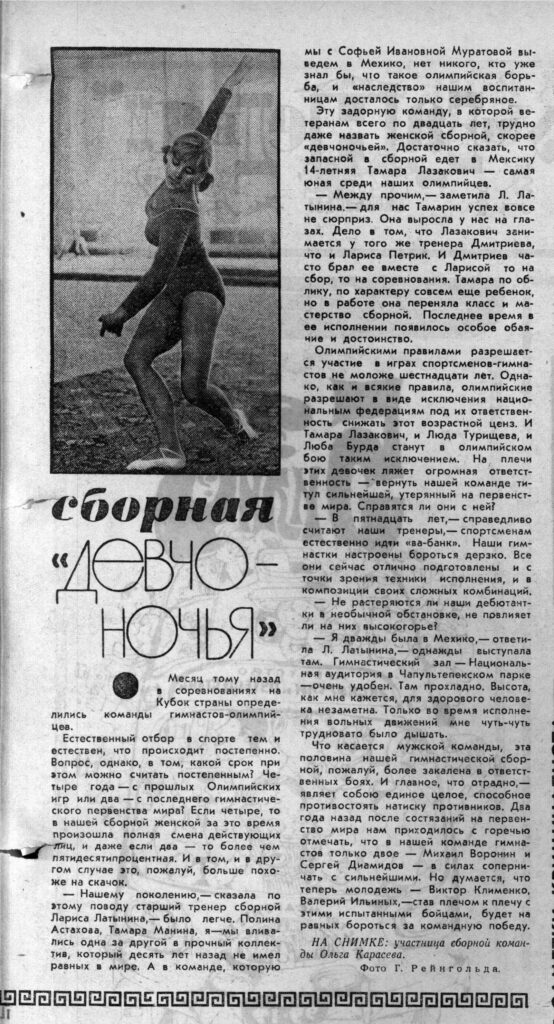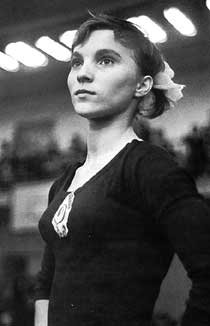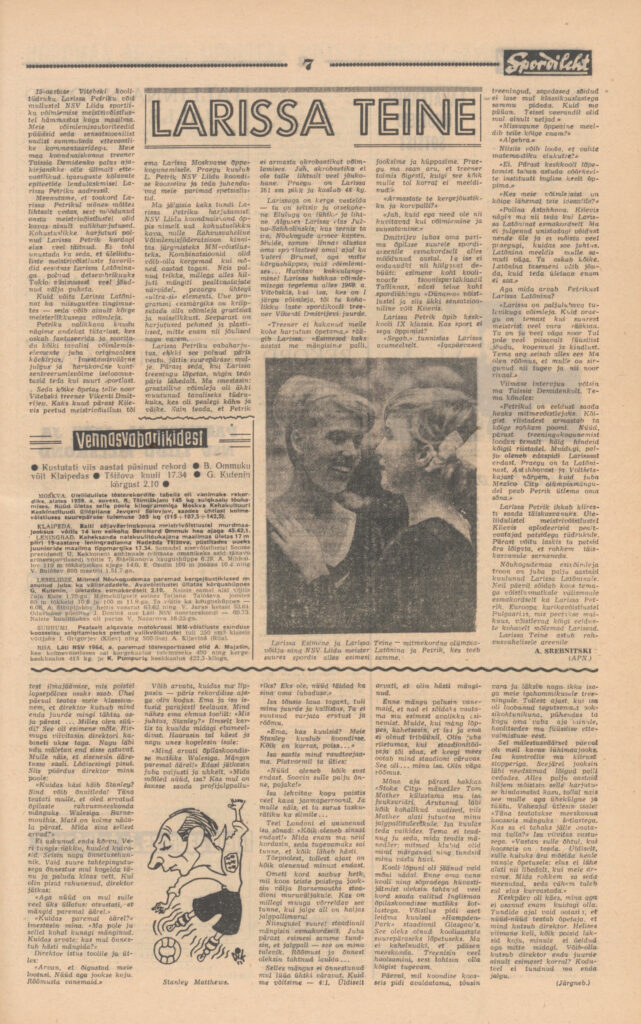Why is our national team suddenly so young? It seems to be a recurring question in the Soviet press in the late 1960s, and there were several explanations.
In an article from 1967, one writer suggested that it’s because the Soviet Union was trying to keep pace with the likes of Věra Čáslavská, who made her international debut at the age of 16 at the 1958 World Championships in Moscow.
The articles from 1968 told a different story.
In the first article below, the explanation will sound more familiar to today’s gym nerds. It has to do with the presumed innocence and naïveté of female gymnasts before they reach adulthood.
In the second article, Larisa Latynina offers a slightly different rendition of the rise of the teenage gymnast.
And finally, we’ll take a look at an Estonian article about Larisa Petrik and what she reportedly did with her pigtails.

These Wonder Girls
“Are you happy?” asked the director’s voice-over.
“I was happy, and now I am not,” answered Natalia Kuchinskaya.
Natasha’s friends on the gymnastics team watched this short documentary, afraid to miss a single word. Perhaps each one wondered, “How would she answer such a question?”
And at this moment on the screen, Natasha was beaming with a medal on her chest. She walked past the stands, as they were enthusiastically chanting, “Natalie! Na-ta-li! “… These were, probably, her minutes of happiness, for which the athlete pays a high price. In the film of the Ukrainian director V. Savelyev, there are several episodes filmed in the training room. Filmed very truthfully — grueling labor to the point of tears, to exhaustion. Endless repetition of a simple skill which then is supposed to turn into complex things… These are the daily experiences of sports.
It is easy to see by visiting the training of the national team. Over the past year or two, our national gymnastics team has become surprisingly younger. Natasha Kuchinskaya, Larisa Petrik, and Zinaida Voronina (Druzhinina), who, when you add up their ages, don’t reach sixty, are already “veterans” in comparison with 16-year-old Ludmilla Tourischeva, who is the winner of the Cup of the country, 15-year-old [Lyubov] Burda, who won last year’s Cup, and Tamara Lazakovich, a medalist of the All-Union Spartakiad for schoolchildren.
However, given the rapid development of international gymnastics, which has made a real leap in difficulty, it is clear that it is easier to get to this level for those who are not burdened by age or fame or the usual ideas about what is difficult and impossible. Indeed, exercises that seemed fantastical at the last Olympic Games are now being performed by the girls on the national team.
In these photos — a rare case! — you can see them all in one gym. It is a rarity, because (and this is also typical of the current qualitative leap in our gymnastics) nine national team girls represent six different cities in the country: Voronezh and Grozny, Kuznetsk and Vitebsk, Moscow and Leningrad. Their coaches are together with their pupils in the gym.
… “If I perform well, it’s not a joy just for me! ” — said in the film “Na-ta-li” Natasha Kuchinskaya. And the truth is the success of each of these girls, selfless and stubborn, is a joy for millions of people who love sports.
(Thanks to Luba and Nico for their help with this translation. Separately, all the risk, originality, and virtuosity bonus points to anyone who can track down this film by Savelyev.)
⁂ ⁂ ⁂
According to the image of the Soviet female gymnast put forth in this article, age, fame, and doubt were seen as burdens. They limited gymnasts, inhibiting them from thinking that anything was possible and from meeting the new difficulty standards in gymnastics.
That’s why the Soviet Union needed young gymnasts — they still believed that anything was possible and could throw hard skills.
Note: I am not arguing that young gymnasts are better gymnasts. Rather, I am highlighting the beliefs and perceptions of this time period and how the image of the teenage gymnast — and, in some ways, the teenager — was being constructed.
Latynina’s View in 1968
In an interview, Larisa Latynina, the head coach of the Soviet women’s team, offered a slightly different perspective. In her view, young gymnasts “go all-in,” but there are trade-offs. They lack experience, and they still need to develop a level of refinement and performance quality.
What follows is a translation of an article from September 1, 1968.

A month ago, the Olympic gymnastics teams were determined at the USSR Cup.
Natural selection is also natural in sports. It happens gradually. The question, however, is, what length of time can be considered gradual? Four years — from the last Olympic Games, or two — from the last gymnastics World Championship? If it’s four, then, during this time, there was a complete turnover of active participants on our women’s national team, and even if it’s two, then more than fifty percent. And in fact, in either case, it is, perhaps, more like a leap.
— Our generation, — said the head coach of the national team Larisa Latynina, — it was easier. Polina Astakhova, Tamara Manina, I — we joined together to form a solid team that, ten years ago, had no equal in the world. And on the team that Sofia Ivanovna Muratova will bring to Mexico City, there is no one who already knows what Olympic competition is like, and our pupils got only a silver “inheritance.”
[The Soviet team won silver at the 1966 World Championships. That’s the inheritance.]
This perky team, in which the veterans are only twenty years old, can hardly even be called a women’s team, rather a “girl” one. Suffice it to say that 14-year-old Tamara Lazakovich, the youngest among our Olympians, is going to Mexico as an alternate for the national team.
— By the way, — L. Latynina noted. — For us, Tamarin’s success is not a surprise at all. She grew up before our eyes. The fact is that Lazakovich is taught by the same coach Dmitriev as Larisa Petrik. And Dmitriev often took her along with Larisa to national team camp, then to competition. Tamara is still a child in appearance, in character, but in her work, she adopted the class and skill of the national team. Recently, a special charm and dignity have appeared in her performance.
Olympic rules allow athletes who are sixteen years of age or older to participate in the Games. However, like any other rules, the Olympic ones allow, as an exception, national federations, under their responsibility, to lower this age limit. And Tamara Lazakovich, and Lyuda Tourishcheva, and Lyuba Burda will become such an exception at the Olympics. A huge responsibility will fall on the shoulders of these girls — to return to our team the title of the strongest, which was lost at the world championship. Will they handle it?
— At fifteen, – our coaches rightly believe, – it is natural for athletes to go “all in.” Our gymnasts are determined to fight boldly. All of them are now perfectly prepared both in terms of performance technique and in the composition of their complex routines.
— Won’t our debutantes be confused in an unusual environment, the highlands have not influenced them?
[Mexico City’s elevation is roughly 7,350 feet. That was a major concern going into the Olympics. More here.]
— I have been to Mexico City twice, — L. Latynina answered, — once I performed there. The gym — the National Auditorium at Chapultepec Park — is very comfortable. It’s cool there. The altitude, it seems to me, is invisible for a healthy person. Only during the performance of floor exercise was it a little difficult for me to breathe.
As for the men’s team, this half of our gymnastics team is perhaps more seasoned in crucial competitions. And the main thing that is gratifying is that it is a single whole, capable of withstanding the onslaught of opponents. Two years ago, after the world championship competitions, we had to note with bitterness that only two gymnasts on our team – Mikhail Voronin and Sergey Diamidov – were able to compete with the strongest. But it seems that now the youth — Viktor Klimenko, Valery Ilinykh, — are standing shoulder to shoulder with these experienced competitors, and will fight on equal terms for a team victory.
⁂ ⁂ ⁂
Note #1: The Olympic Games technically did not have an age limit. According to the 1966 Olympic Charter:
No age limit is prescribed by the International Olympic Committee for competitors in the Olympic Games.
Aucune limite d’âge n’est prescrite par le Comité International Olympique pour les concurrents aux Jeux Olympiques.
Olympic Charter, 1966
Note #2: Age is a topic that Latynina addressed over and over in her interviews. She usually called attention to young gymnasts’ performance quality (or lack thereof).
Goodbye, Pigtails!
While Soviet sportswriters were focused on the question of age, not all gymnasts wanted to call attention to their youthfulness. In fact, some wanted to be seen as older than they were.
According to the Estonian newspaper Spordileht, Petrik didn’t enjoy being seen as a child. So, after she won the 1964 Soviet Nationals at the age of 15, she reportedly cut off her pigtails — the look that many a Soviet gymnast would sport, including Tourischeva and Korbut.

Note: The cutting of the pigtails may have been more metaphorical than literal because she had pigtails, albeit short, stubby ones, at the 1965 European Championships.
Before Larisa Latynina and Larisa Petrik headed to the 1965 European Championships, Spordileht reported:
Larisa Petrik wants to grow up fast. Spectators at the All-Union Championship in Kyiv applauded the girl with pigtails. After the win, she had her pigtails cut off to look more like an adult.
Spordileht, March 29, 1965
Larissa Petrik ihkab kiiresti saada täiskasvanuks. Üleliidulistel meistri võistlustel Kiievis aplodeerisid pealtvaatajad patsidega tüdrukule. Pärast võitu laskis ta patsid ära lõigata, et rohkem täiskasvanule sarnaneda.
An interesting tidbit from the Estonian article: The Soviet coaches wanted journalists to keep quiet about Petrik’s win over Latynina in 1964. I’d presume that they wanted to protect Latynina’s reputation.
Our gymnastics authorities tried to tamp down this sensational news with cautious comments. The coach of our country’s national women’s team, Taissia Demidenko, asked journalists to be extremely careful in throwing all kinds of resounding epithets at Larisa Petrik.
Spordileht, March 29, 1965
Meie võimlemisautoriteedid püüdsid seda sensatsioonilist uudist summutada ettevaatlike kommentaaridega. Meie maa koondnaiskonna treener Taissia Demidenko palus ajakirjanikke olla ülimalt ettevaatlikud – igasuguste kõlavate epiteetide lendulaskmisel Larissa Petriku aadressil.
You can read an English translation of the full Petrik interview here.
Note: By no means did the Soviet Union invent the image of the pigtailed teenage gymnast. At the 1948 Olympics in London, the organizers highlighted 17-year-old Italian gymnast Laura Micheli and her pigtails:
Pigtailed L. Micheli of Italy, a serious little girl of 17, was placed third in total marks. What an achievement at that age against so much experience! On one occasion, when she had just finished an exercise perfectly, she forgot all her seriousness and ran back to the team with kisses all round!
The Official Report of the Organising Committee for the XIV Olympiad
There weren’t official all-around rankings at the 1948 Olympics for the women (just team rankings). So, this is a hypothetical third place.

More on 1968